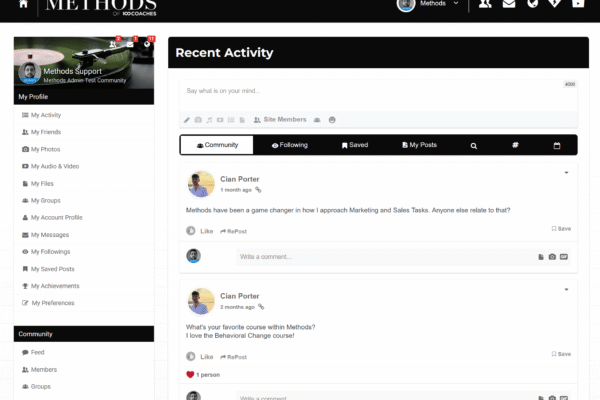It’s no surprise that corporate leadership and management training have changed over the years, certainly after the 2020 pandemic began. Companies used to send their employees to various training conferences across the world or fly in corporate trainers for various needs. The trainers would fly in and spend a few days running workshops at the office or in a hotel conference room that was rented for the occasion. Topics ranged from accountability to leadership, to even more nuts-and-bolts types of training such as corporate tax compliance.
Although not all of this type of training is completely gone, and will likely return in full force after the pandemic ends, it’s not ideal for companies with a workforce that works primarily from home, or from different locations across the world. Employees—now more than ever—need to continue to grow their skills because of how fast things are changing. If they don’t keep up, they will fall behind, and so will the companies they work for.
The following are three corporate training challenges common to companies of all sizes. Let’s take a look at them and the solutions to these challenges.

1. Challenge: Lack of Corporate Training Strategy
Companies understand that employee training is important but more often than not there is no real strategy as to how to deploy the training to internal teams. This lack of clear direction on how to approach training leads to a virtual standstill. To help solve this issue, these are common questions that need to be answered in order to successfully integrate a training program.
“Can the content and strategy for the training be developed internally?”
If the company decides to develop the content internally, this will be a significant investment of resources, both human and financial, because the development of quality training material doesn’t magically appear. A team has to plan, create and deploy said training.
“Are the training activities connected to the overall competency goals of the organization?”
For example, companies may decide to bring in an executive trainer for a few days to help their top managers. The executive trainer will lead sessions on behavior change and leadership development. However, just down the hall, a different manager found online training for her team that is similar—but different. The company will now have two different groups of employees that have been trained on behavior change and leadership with different tactics, creating a split in effectiveness. The training fails to assimilate top managers with middle managers. The company now has a disconnect and a communication barrier when differently-trained employee groups discuss and implement the knowledge and practices from their training, which is not ideal.
“Should the training be outsourced? If it is outsourced, how will the training be delivered—in person, online, or a hybrid?”
If the training is outsourced, the company has to be certain that everyone that needs to get trained receives the same training in order to maintain consistency in implementation. If it is in-person training, one issue that companies may run into is ‘who gets to go train and when?’ The business has to keep going. If you send a whole department to in-person training, who is going to do that department’s tasks while they train? Companies have to consider not only the cost of the training—plane tickets, food, lodging—but the person-hour cost as well. In-person training can also involve the trainer coming to the company’s office to train employees, which is cheaper in some respects, but still costs money and raises its own set of logistical questions.
Solution: Online/Hybrid Built-in Leadership and Manager Training Strategy
An online solution allows employees to train as their schedule allows, making it a win-win situation for the employee and the employer as growth happens for both when the training is effective.
Another solution is hybrid training that allows for self-paced online training with a built-in monthly lunch or meeting where the team gathers to discuss what was learned. The hybrid solution works well as a collaborative, cohort-type model. This makes learning more enjoyable and effective, as the shared discussions encourage collaboration and apply the training to a team’s specific needs to help further a company’s mission and initiatives.
A pre-built, out-of-the-box strategy with pathways and competencies that can be assigned to specific employees and/or whole departments ensures consistency in a company’s training initiatives.
For example, a company training their employees utilizing the Methods of 100 Coaches platform can have their executive managers learning from Marshall Goldsmith’s Methods of Behavioral Change course. Once the team has completed the course, everyone would have an understanding of how to find their own ‘behavioral triggers’ to help master their job, environment, and life. If the company then decides to train middle managers on the same course, the terminology and tactics learned would be consistent across the board, so there would be a natural synergy and clarity of direction due to the use of the same training for the different management teams.

2. Challenge: No Metrics to Measure Training Effectiveness
Investing in training is something that can have lasting results for both a company and employees. But how does a company or manager know if the training achieved the results intended? If employees go to a conference for training, or a coach comes to their organization to train on anything from accounting to accountability, how do you measure the effectiveness? There is no reporting: a manager has to go by what the employees do and say. Was it good? Did they learn anything? Will they be able to implement what they learned? Did the information get retained by those that attended the training?
This is a major challenge when a manager or a company is trying to measure how much was learned and retained. There is no reporting and no administrative tools that help managers know how good or bad, effective or lackluster the training was for their teams.
Solution: Accountability Reports and Retention Tools
A good training system, especially an online system, provides great accountability and reporting tools to managers. A manager should be able to see how much training employees are completing and how well they are understanding the material by reviewing assessments. On the other end of that, an employee should have the ability to see their progress at-a-glance, while at the same time feeling encouraged by what they are learning.
The training should have knowledge retention at the forefront of everything else. What is the point of investing in any type of training if employees will not retain and grow from it? Traditional online training systems use video to help with engagement, but what they completely miss out on is role-playing and interactivity to help with retention.
For example, in our Methods of 100 Coaches course with Peter Bregman, he asks a question about the last time you had to have a tough conversation with someone. He provides three options for the person training to choose from, depending on the answer, Peter coaches the person on their selection. The interactivity keeps the person engaged; instead of hitting play on the video and then leaving, they are required to think, encouraged to participate in their own training, and they, therefore, retain the information. In essence, it’s almost like having that coach in the room with you, guiding your thought process and teaching you the important concepts.
To demonstrate what we mean, watch Peter Bregman coach you through emotional courage:

3. Challenge: No Efficiencies of Scale
It is difficult to send everyone to training at the same time because—as mentioned previously—a business still has to run on the day-to-day. Even if a company does a ‘retreat’ to get the training done, it can become expensive and logistics become an issue if you have employees at different locations. What if you hired someone to come do the training at your location? The question becomes: who do you send and when? The trainer probably can be there for a few days, but how much of that training would be retained in that short amount of time? In the end, the retention of the content in these types of situations is minimal considering the investment.
It is hard to scale from five employees to 50 in an efficient way with traditional training.
Solution: Effective Scaling
Instead of having to figure out logistics and who needs to be trained, an online training solution allows for a company to scale as needed. For example, a company can invest in subscriptions to a training system and put a team of managers on it. The managers can then go through the training in a self-paced fashion or in a hybrid/cohort model to see if the training is what the company wants to invest in for their employees.
Once at least a course is complete and a decision is made, the company can then purchase additional training subscriptions for their entire organization. All of this happens without disrupting the regular flow of business—without having to figure out logistics of who needs to fly where and when. And, the best part is that everyone is learning from the same training, which not only benefits them in terms of the material learned but also helps to further build up the culture of an organization.
The investment is minimal when compared to the costs associated with traditional training which include flights, hotels, per diems, and other logistics that happen when sending employees to conferences or events or similar training activities
At the end of the day, a company needs to do its due diligence and find out what works best for them. But with where we are today, an online training solution is one that can make a big, scalable impact with minimal investment. The challenge of effectively training both managers and employees has been around since the dawn of business, but with the advent of fast-paced technology, the solutions can be simpler and more efficient.
If you are looking for online corporate business and leadership training, we’d love for you to learn more about Methods of 100 Coaches and book a demo to showcase our interactive learning management system. The demo will provide valuable information where you can see why top companies around the world are utilizing the Methods platform to help their organizations continue to grow their talent, and why you should too.
Not ready for a demo but want to receive business and leadership tips directly in your inbox?





